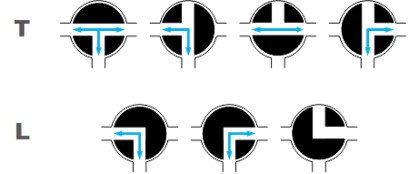A ball valve is a globe valve that controls the flow of a liquid or gas by means of a rotating ball with an internal bore. By rotating the ball a quarter turn (90 degrees) about its axis, the medium can flow through or be blocked. Ball valve is characterized by its long service life, providing a reliable seal for the life of the valve, even if the valve is not used for a long time. For this reason, ball valves are preferred as globe valves over gate valves. For a complete comparison, read our article on gate valves vs. ball valves. In addition, they are more resistant to contaminated media than most other types of valves. In special versions, ball valves can also be used as control valves. This application is less common because of the relatively limited accuracy in controlling flow compared to other types of control valves. However, the valve has some advantages here as well. For example, it still ensures a reliable seal, even in dirty media. Figure 1 shows a cross-sectional view of a ball valve.
As previously described, a ball valve consists of a rotating ball with an internal bore. The ball is connected to a stem that is attached to a lever. In manually operated valves, the valve can be opened and closed by turning the lever (this can also be done with electric or pneumatic actuators). In order to allow the flow of water to pass, the holes should be aligned in the direction of the fluid flow. To block the flow, the ball can be rotated perpendicular to the flow path.
A ball valve can have 2, 3 or even 4 ports. Most ball valves are bi-directional and are manually operated with a lever. In the open position, the lever is in line with the pipe. When in the closed position, the lever is perpendicular to the pipe. Manually operated ball valves can be at risk of water hammer due to fast flowing media and fast closing valves. Three-way valves are available with an L or T orifice, as can be seen in the diagram below. This pattern facilitates different circuit functions, such as distribution or mixing of flows.

● Simple structure, smaller weight and volume, easy to disassemble and repair.
● Ball valve can be used for a long time, because the stem just rotates, the packing seal of the stem is not easy to be destroyed, the sealing capacity increases with the increase of medium pressure.
● Fluid resistance is small, full bore ball valves basically have no flow resistance. Pneumatic ball valve is one of the smallest fluid resistance among all valve classifications.
● Simple and rapid operation, only 90° rotation from full open to full close, easy to control from a distance.
● Wide range of applications, from a few millimeters to several meters, from high vacuum to high pressure.
But there are also disadvantages of ball valves.
● Ball valves can only be fully open or fully closed and cannot be used for throttling. This is because of the relatively limited accuracy of controlling the flow rate. Throttling applications are more likely to use globe valves.
● Because of the cavity around the ball and seat, it is not suitable for mud or gravel applications. Mud tends to solidify or clog in the cavity, greatly increasing the operating torque of the valve and in some cases making the valve inoperable, and abrasive solids suspended in the fluid may increase friction when the ball and seat come in contact thereby damaging the seat and ball surfaces.
● Water hammer can now be reduced by adding additional fittings to the valve.
● Water hammer can now be reduced by adding additional fittings to the valve.
● Abrasive solids suspended in the fluid may damage the seat and ball surfaces because of the wipe-on motion of the ball on the seat.
● Some ball valve designs may be difficult to clean.
1481
0
1
All Comments (0)
Previous: When you Should Use a Gate Valve
Next: None
Related Articles
If you are interested in sending in a Guest Blogger Submission,welcome to write for us!
Comments